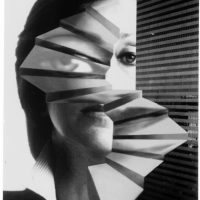fotó, vintage / photo, vintage
Sammlung Verbund, Bécs / Vienna
fotómontázs, farost / photomontage on wood
Szent István Király Múzeum, Székesfehérvár
The portrait is one of the most influential genres of fine art: traditionally its aim is to represent the human face, to depict a person’s appearance and personality. Though this definition of the genre may seem simple, the last decades have not seen many significant artworks that would fully suit its prerequisites.
Apparently, this kind of representation falls outside the scope of contemporary art: today the represented face is much more a means of expression than in previous times of art history.
The question “What is the significance of the portrait today?” is clearly a valid and timely one. What kind of function may this genre serve in the age of photography, film and the virtual? Who does the late 20th and early 21th century portrait represent and why? What sort of social function may the genre of the portrait serve today?
These are the fundamental questions of the exhibition Through a Glass Darkly which also wishes to pay homage to the memory of the art collector and museum-founder Lajos Ernst on the occasion of the one hundred year anniversary of his museum. First and foremost, Ernst was a collector and exhibitor of portraits: during his leadership, the permanent exhibition of the Budapest Ernst Museum consisted mainly of historical portraits of poets, artists and public figures.
The present exhibition involves several works commemorating Ernst’s art collection, however, in contrast with his romantic, heroic organising principle, the intention of the present show is to shed light on the artistic changes of the last four decades regarding the means, motives and goals of the representation of the human face.


